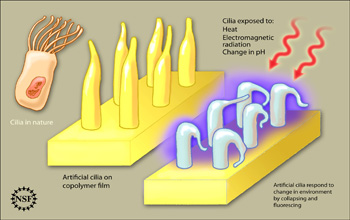News Release 10-171
Cilia Revolution
Man-made, hair-like structures poised to change industry paradigms

Newly developed artificial cilia respond to changes in heat, electromagnetic radiation and acidity.
September 23, 2010
This material is available primarily for archival purposes. Telephone numbers or other contact information may be out of date; please see current contact information at media contacts.
University of Southern Mississippi scientists recently imitated Mother Nature by developing, for the first time, a new, skinny-molecule-based material that resembles cilia, the tiny, hair-like structures through which organisms derive smell, vision, hearing and fluid flow.
While the new material isn't exactly like cilia, it responds to thermal, chemical, and electromagnetic stimulation, allowing researchers to control it and opening unlimited possibilities for future use.
This finding is published in today's edition of the journal Advanced Functional Materials. The National Science Foundation's Division of Materials Research supports Southern Miss's Materials Research Science and Engineering Center for Response-Driven Polymeric Materials, where the research took place.
Cilia are wavy, hair-like structures that extend outward from the surfaces of various organisms such as human skin. People, animals and single-celled organisms use them to sense the environment, gather information about it and adapt to it.
Scientists long imagined what could be done if they could engineer cilia for other organic and nonorganic uses. But creating them solely belonged to the life nurturing processes of nature, until now. Marek Urban, Southern Miss professor of polymer science and engineering, along with a team of researchers, developed a new thin copolymer film with whisker-like formations that mimics Mother Nature.
"Our interest is in developing materials with multi-level responses at various length and time scales," said Urban. "I believe this is the future of science and engineering that will drive future technologies."
Employing a process used for years to produce latex paints, the researchers formed thin copolymer-based films whose chemical composition makes possible filaments that have built-in molecular sensors that respond to temperature, acidity and ultraviolet radiation. Moreover, the filaments are capable of locomotion, waving, shrinking and expanding in response to stimuli. They also are capable of fluorescence, that is, absorbing and emitting light and changing colors as a reaction to ultraviolet rays.
The ability to engineer this cilia-like biosensor may give scientists an ability to, for example, test for the presence of toxins, oxygen or even lack of oxygen in an environment. Future opportunities for sensor use might include developing new sensors for testing glucose levels, using the sensors for drug testing, or testing for air or water safety.
There is no limit to dreaming up applications for such a material, said Urban. "Many new ideas are being generated as we speak, but it is too early to reveal them."
Immediate next steps will be to team up engineers to make use of the materials.
Former Southern Miss graduate students Fang Liu, who now works with Proctor and Gamble, and research associate Dhanya Ramachandran contributed to this research.
-NSF-
Media Contacts
Bobbie Mixon, NSF, (703) 292-8485, email: bmixon@nsf.gov
Program Contacts
Thomas P. Rieker, NSF, (703) 292-4914, email: trieker@nsf.gov
Principal Investigators
Marek W. Urban, The University of Southern Mississippi, (601) 266-6868, email: marek.urban@usm.edu
Related Websites
Advanced Functional Materials: Colloidal Films That Mimic Cilia: http://onlinelibrary.wiley.com/doi/10.1002/adfm.201000379/pdf
The U.S. National Science Foundation propels the nation forward by advancing fundamental research in all fields of science and engineering. NSF supports research and people by providing facilities, instruments and funding to support their ingenuity and sustain the U.S. as a global leader in research and innovation. With a fiscal year 2023 budget of $9.5 billion, NSF funds reach all 50 states through grants to nearly 2,000 colleges, universities and institutions. Each year, NSF receives more than 40,000 competitive proposals and makes about 11,000 new awards. Those awards include support for cooperative research with industry, Arctic and Antarctic research and operations, and U.S. participation in international scientific efforts.
Connect with us online
NSF website: nsf.gov
NSF News: nsf.gov/news
For News Media: nsf.gov/news/newsroom
Statistics: nsf.gov/statistics/
Awards database: nsf.gov/awardsearch/
Follow us on social
Twitter: twitter.com/NSF
Facebook: facebook.com/US.NSF
Instagram: instagram.com/nsfgov
